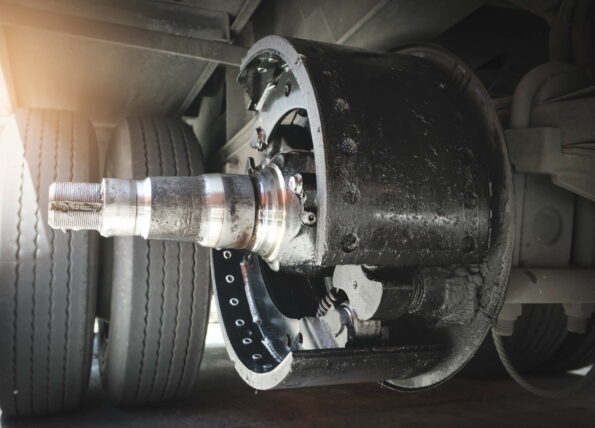Brake systems on modern heavy vehicles are supported by safety systems such as ABS (anti-lock braking system), EBS (electronic braking system), ESC (electronic stability control) and ASR (anti-slip regulation).
The most common system medium and heavy trucks is a pneumatic (air) system. This system contains:
- service brakes
- parking brakes
- treadle valve (brake pedal)
- safety relay valves
- air compressor
- air tanks
The parking brake is a disk or drum, held in the applied position by spring pressure via a brake pot. When the vehicle’s engine is started, air pressure builds and this releases the ‘spring brake’. If there’s no air pressure, the brakes are on by default. This helps stop a disconnected trailer from running away.

The servicing brakes are operated when the brake pedal is pushed. This routes air under pressure to the brake pot, causing the brake to engage. This air is typically 100-120psi.
Brakes are roller-tested to check they work. This involves one axle at a time being driven over a set of rollers that measure braking efficiency and imbalance. Braking efficiency measures the relationship between the weight on the axle being tested and total vehicle brake force.
If the braking performance is not the same on the right and left of the axle, this is called an ‘imbalance’. There’s a maximum imbalance of 30% allowed, otherwise the vehicle won’t pass the inspection.
Conversion of one form of energy to another
Energy cannot be created or destroyed, it simply gets changed from one form to another. In the case of brakes, they convert motion, or kinetic energy, into heat (thermal energy) by using friction to slow the rotation of the wheel. The faster the vehicle is moving, the more kinetic energy that exists. Doubling the speed quadruples the kinetic energy.
If the brakes overheat, you can get brake fade. This can happen if you boil the brake fluid or you overheat the brake components. When the brake components, such as the discs and pads, are overheated, a superheated film of gas reduces the friction the brake can provide. In extreme cases, the whole disk can crack, in which case you might feel it through the brake pedal as a pulsing. If the brake fluid boils, then it can’t provide the pressure required to apply the brakes – the pedal might go right to the floor.
It’s advised to use the retarder for slowing the truck down, not the service brakes. The service brakes are used to bring the truck to a stop.
Troubleshooting
A strong smell and excessive heat from a wheel is often a sign of a dragging brake. This can heat up the wheel hub, so is detectable after a long drive – one hub will be warmer than the other on the opposite side.
If you notice oil around the brake components, this requires immediate attention.
A metal sound when braking often indicates that the pads or drums are worn too far and now it’s metal on metal. Immediate attention is required.
If the vehicle pulls to one side while braking, this is a sign of brake imbalance. This needs to be looked it as soon as possible.
